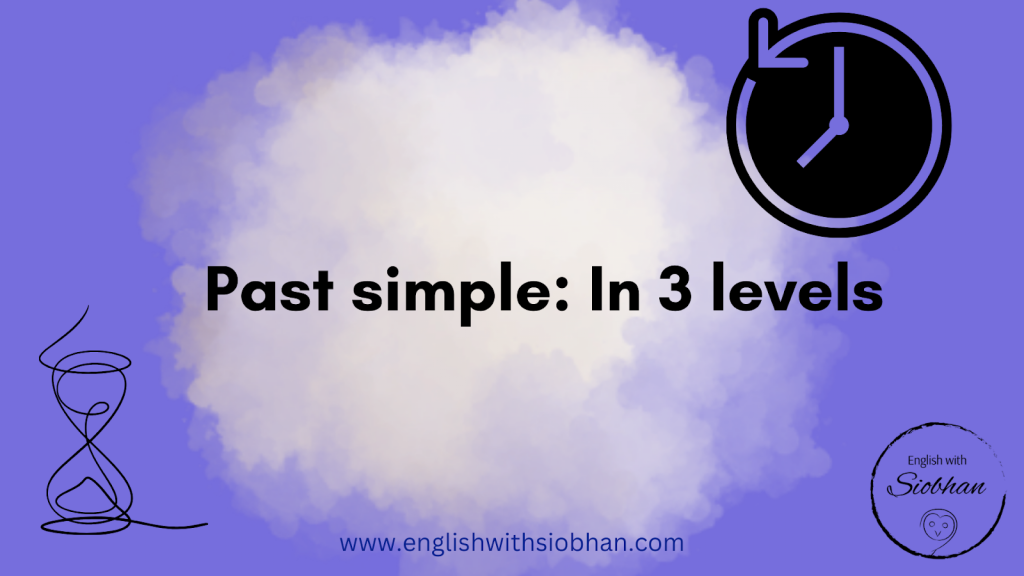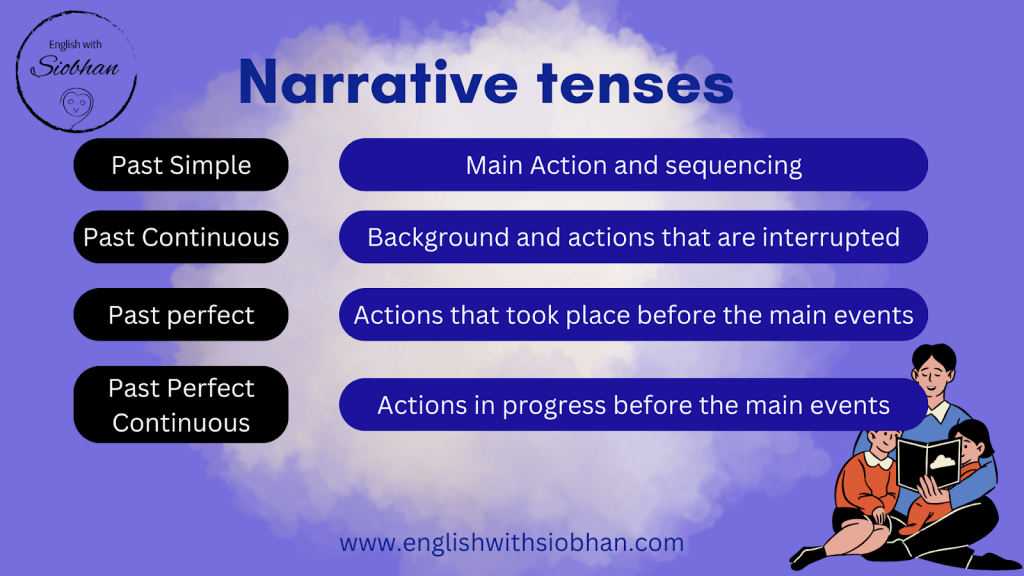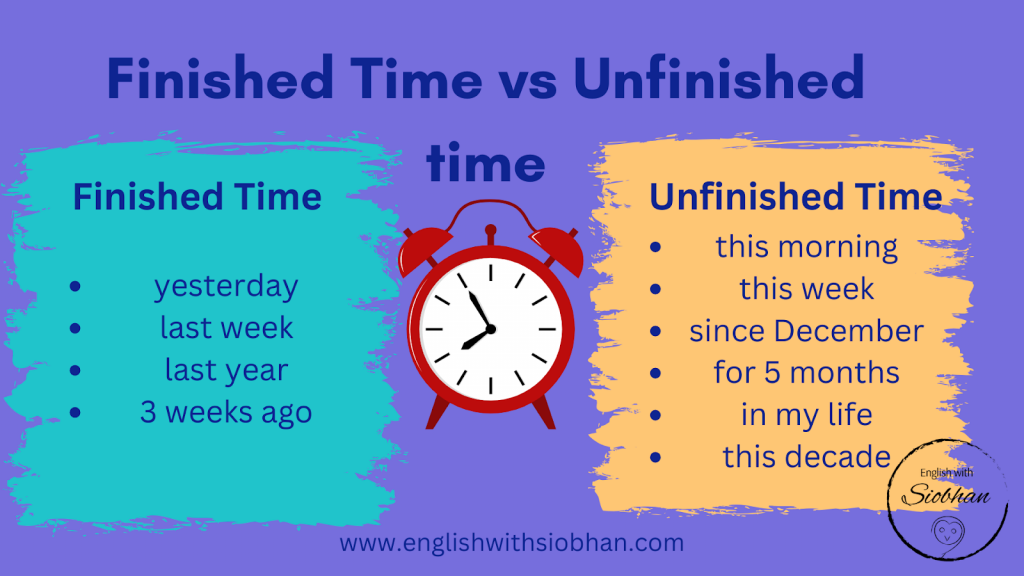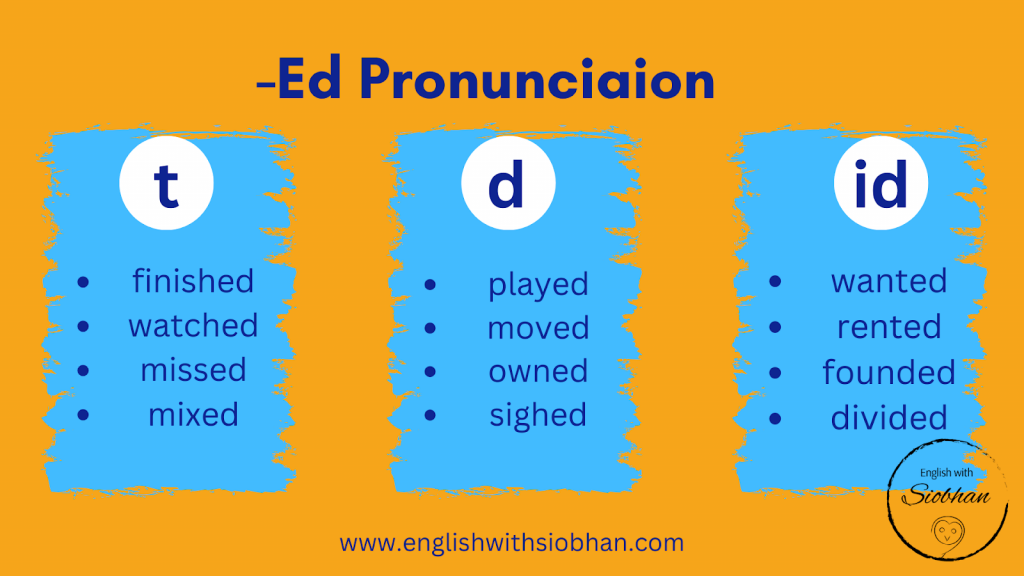The past simple is one of the first “complicated” structures taught to English learners. Here we will explore what students need to know about this tense in 3 levels – for elementary students, intermediate students, and advanced students.
For regular verbs, we either add -ed or -d to the end of the verb. It is the same for each person (I, you,she, we, etc), so you only have to remember one form for each verb!
For irregulars, it is a little trickier. The verb keeps the same for each person, but you will have to memorise the form for each irregular verb
We use the past simple for single events that happened in the past. For example, On Saturday I went to the cinema.
It can also be used for situations that were true in the past. E.g. When I was a child I lived in London
The past simple is one of the narrative tenses. These are tenses used in story telling and we will discuss these in more detail in a separate post. In short, the narrative tenses are made up of the past simple, past continuous, past perfect, and past perfect continuous. Amongst these, the past simple is used for the main events and to show consecutive actions.
Notice how the main events are in the past simple. Even with other tenses in between we can follow the action as the past simple provides the sequencing, he went to the park, he came across a dog, he remembered something, then he took the dog home.
A lot of students confuse the present perfect and the past simple. The easiest way to think about the difference between these two tenses is as finished time vs unfinished time. Finished time is the past simple. The action has happened and cannot happen again. This is shown with time expressions such as yesterday, last week, 5 years ago. E.g. I went to Madrid last year. Unfinished time is the present perfect. The time frame has not finished and so the action may happen again. This is shown either by an absence of time expressions or open time expressions such as today, this week, this month, since 2016, for 10 years. For example, I have visited Madrid 5 times and I have lived in Spain for 10 years.
We can also use the past simple (and the past continuous) with some verbs for things we intended to, but didn’t actually do.
This is the simplest rule of the 3. We pronounce -d endings /id/ if the last sound of the verb is /d/ or /t/. So wanted is pronounced /ˈwɒntɪd/ and divide is pronounced /dɪˈvaɪdɪd/. Notice how we aren’t interested in the last letter, only the sound.
Here we need to pay attention to the final sound. If the final sound in unvoiced, /p/, /f/
/s/, /ʃ/ (finish), /k/ /tʃ/ (watch), the -ed ending makes a /t/ sound. Notice how we don’t add an extra syllable. So finished sounds like /ˈfɪnɪʃt/, going straight from the “sh” sound to the “t”
All verbs end with a /d/ sound. So played is /pleɪd/, lived is /lɪvd/ and /ˈlɪsᵊnd/. Notice how again we don’t add an extra syllable added. We go straight from the final sound to the /d/.
The past simple is one of the first tenses students learn. Each level adds a little more detail to the previous one. The trickiest part of this tense is mastering the irregular verbs, but with practice and more exposure through reading and listening, this will become easier.
[{"id":364,"link":"https:\/\/englishwithsiobhan.com\/the-conditionals-in-3-levels\/","name":"the-conditionals-in-3-levels","thumbnail":{"url":"https:\/\/englishwithsiobhan.com\/wp-content\/uploads\/2024\/05\/image-8.png","alt":""},"title":"The Conditionals: In 3 levels","author":{"name":"Siobhan","link":"https:\/\/englishwithsiobhan.com\/author\/admin\/"},"date":"May 20, 2024","dateGMT":"2024-05-20 08:50:11","modifiedDate":"2024-05-20 10:01:58","modifiedDateGMT":"2024-05-20 09:01:58","commentCount":"0","commentStatus":"open","categories":{"coma":"<a href=\"https:\/\/englishwithsiobhan.com\/category\/grammar\/\" rel=\"category tag\">Grammar<\/a>","space":"<a href=\"https:\/\/englishwithsiobhan.com\/category\/grammar\/\" rel=\"category tag\">Grammar<\/a>"},"taxonomies":{"post_tag":"<a href='https:\/\/englishwithsiobhan.com\/tag\/advanced\/' rel='post_tag'>advanced<\/a><a href='https:\/\/englishwithsiobhan.com\/tag\/elementary\/' rel='post_tag'>elementary<\/a><a href='https:\/\/englishwithsiobhan.com\/tag\/grammar\/' rel='post_tag'>grammar<\/a><a href='https:\/\/englishwithsiobhan.com\/tag\/intermediate\/' rel='post_tag'>intermediate<\/a>"},"readTime":{"min":5,"sec":43},"status":"publish","excerpt":""},{"id":358,"link":"https:\/\/englishwithsiobhan.com\/upgrade-your-listening-skills-where-to-practise-for-free-online\/","name":"upgrade-your-listening-skills-where-to-practise-for-free-online","thumbnail":{"url":"https:\/\/englishwithsiobhan.com\/wp-content\/uploads\/2024\/05\/image-7.png","alt":""},"title":"Upgrade your Listening Skills: Where to Practise for Free Online","author":{"name":"Siobhan","link":"https:\/\/englishwithsiobhan.com\/author\/admin\/"},"date":"May 13, 2024","dateGMT":"2024-05-13 07:17:56","modifiedDate":"2024-05-13 08:18:53","modifiedDateGMT":"2024-05-13 07:18:53","commentCount":"0","commentStatus":"open","categories":{"coma":"<a href=\"https:\/\/englishwithsiobhan.com\/category\/english-tips\/\" rel=\"category tag\">English Tips<\/a>","space":"<a href=\"https:\/\/englishwithsiobhan.com\/category\/english-tips\/\" rel=\"category tag\">English Tips<\/a>"},"taxonomies":{"post_tag":"<a href='https:\/\/englishwithsiobhan.com\/tag\/advanced\/' rel='post_tag'>advanced<\/a><a href='https:\/\/englishwithsiobhan.com\/tag\/elementary\/' rel='post_tag'>elementary<\/a><a href='https:\/\/englishwithsiobhan.com\/tag\/intermediate\/' rel='post_tag'>intermediate<\/a><a href='https:\/\/englishwithsiobhan.com\/tag\/listening\/' rel='post_tag'>listening<\/a><a href='https:\/\/englishwithsiobhan.com\/tag\/tips\/' rel='post_tag'>tips<\/a>"},"readTime":{"min":2,"sec":37},"status":"publish","excerpt":""},{"id":321,"link":"https:\/\/englishwithsiobhan.com\/sentence-stress-in-english\/","name":"sentence-stress-in-english","thumbnail":{"url":"https:\/\/englishwithsiobhan.com\/wp-content\/uploads\/2024\/03\/Siobhan-Williams.png","alt":""},"title":"Why English Speakers are Difficult to Understand: Part 1 Sentence Stress","author":{"name":"Siobhan","link":"https:\/\/englishwithsiobhan.com\/author\/admin\/"},"date":"May 8, 2024","dateGMT":"2024-05-08 08:02:43","modifiedDate":"2024-05-08 09:02:45","modifiedDateGMT":"2024-05-08 08:02:45","commentCount":"0","commentStatus":"open","categories":{"coma":"<a href=\"https:\/\/englishwithsiobhan.com\/category\/english-tips\/\" rel=\"category tag\">English Tips<\/a>","space":"<a href=\"https:\/\/englishwithsiobhan.com\/category\/english-tips\/\" rel=\"category tag\">English Tips<\/a>"},"taxonomies":{"post_tag":"<a href='https:\/\/englishwithsiobhan.com\/tag\/advanced\/' rel='post_tag'>advanced<\/a><a href='https:\/\/englishwithsiobhan.com\/tag\/elementary\/' rel='post_tag'>elementary<\/a><a href='https:\/\/englishwithsiobhan.com\/tag\/intermediate\/' rel='post_tag'>intermediate<\/a><a href='https:\/\/englishwithsiobhan.com\/tag\/pronunciation\/' rel='post_tag'>pronunciation<\/a><a href='https:\/\/englishwithsiobhan.com\/tag\/tips\/' rel='post_tag'>tips<\/a>"},"readTime":{"min":2,"sec":42},"status":"publish","excerpt":""},{"id":258,"link":"https:\/\/englishwithsiobhan.com\/past-simple-in-three-levels\/","name":"past-simple-in-three-levels","thumbnail":{"url":"https:\/\/englishwithsiobhan.com\/wp-content\/uploads\/2024\/04\/image-9.png","alt":"Past simple in 3 levels"},"title":"The Past Simple- in 3 levels","author":{"name":"Siobhan","link":"https:\/\/englishwithsiobhan.com\/author\/admin\/"},"date":"Apr 29, 2024","dateGMT":"2024-04-29 08:14:59","modifiedDate":"2024-04-29 10:28:16","modifiedDateGMT":"2024-04-29 09:28:16","commentCount":"0","commentStatus":"open","categories":{"coma":"<a href=\"https:\/\/englishwithsiobhan.com\/category\/grammar\/\" rel=\"category tag\">Grammar<\/a>","space":"<a href=\"https:\/\/englishwithsiobhan.com\/category\/grammar\/\" rel=\"category tag\">Grammar<\/a>"},"taxonomies":{"post_tag":"<a href='https:\/\/englishwithsiobhan.com\/tag\/advanced\/' rel='post_tag'>advanced<\/a><a href='https:\/\/englishwithsiobhan.com\/tag\/elementary\/' rel='post_tag'>elementary<\/a><a href='https:\/\/englishwithsiobhan.com\/tag\/grammar\/' rel='post_tag'>grammar<\/a><a href='https:\/\/englishwithsiobhan.com\/tag\/intermediate\/' rel='post_tag'>intermediate<\/a><a href='https:\/\/englishwithsiobhan.com\/tag\/past\/' rel='post_tag'>past<\/a><a href='https:\/\/englishwithsiobhan.com\/tag\/past-simple\/' rel='post_tag'>past simple<\/a><a href='https:\/\/englishwithsiobhan.com\/tag\/pronunciation\/' rel='post_tag'>pronunciation<\/a>"},"readTime":{"min":3,"sec":32},"status":"publish","excerpt":""},{"id":219,"link":"https:\/\/englishwithsiobhan.com\/14-english-and-spanish-false-friends\/","name":"14-english-and-spanish-false-friends","thumbnail":{"url":"https:\/\/englishwithsiobhan.com\/wp-content\/uploads\/2024\/04\/image-5.png","alt":""},"title":"False Friends: 14 Fascinating English and Spanish Examples that can Confuse Learners","author":{"name":"Siobhan","link":"https:\/\/englishwithsiobhan.com\/author\/admin\/"},"date":"Apr 23, 2024","dateGMT":"2024-04-23 07:44:41","modifiedDate":"2024-04-23 09:02:53","modifiedDateGMT":"2024-04-23 08:02:53","commentCount":"0","commentStatus":"open","categories":{"coma":"<a href=\"https:\/\/englishwithsiobhan.com\/category\/english-tips\/\" rel=\"category tag\">English Tips<\/a>","space":"<a href=\"https:\/\/englishwithsiobhan.com\/category\/english-tips\/\" rel=\"category tag\">English Tips<\/a>"},"taxonomies":{"post_tag":"<a href='https:\/\/englishwithsiobhan.com\/tag\/advanced\/' rel='post_tag'>advanced<\/a><a href='https:\/\/englishwithsiobhan.com\/tag\/false-friends\/' rel='post_tag'>false friends<\/a><a href='https:\/\/englishwithsiobhan.com\/tag\/intermediate\/' rel='post_tag'>intermediate<\/a><a href='https:\/\/englishwithsiobhan.com\/tag\/spanish\/' rel='post_tag'>spanish<\/a><a href='https:\/\/englishwithsiobhan.com\/tag\/tips\/' rel='post_tag'>tips<\/a>"},"readTime":{"min":4,"sec":51},"status":"publish","excerpt":""},{"id":202,"link":"https:\/\/englishwithsiobhan.com\/the-present-simple-in-3-levels\/","name":"the-present-simple-in-3-levels","thumbnail":{"url":"https:\/\/englishwithsiobhan.com\/wp-content\/uploads\/2024\/04\/image-3.png","alt":""},"title":"The Present Simple- In 3 levels","author":{"name":"Siobhan","link":"https:\/\/englishwithsiobhan.com\/author\/admin\/"},"date":"Apr 15, 2024","dateGMT":"2024-04-15 07:56:43","modifiedDate":"2024-05-03 10:25:27","modifiedDateGMT":"2024-05-03 09:25:27","commentCount":"0","commentStatus":"open","categories":{"coma":"<a href=\"https:\/\/englishwithsiobhan.com\/category\/grammar\/\" rel=\"category tag\">Grammar<\/a>","space":"<a href=\"https:\/\/englishwithsiobhan.com\/category\/grammar\/\" rel=\"category tag\">Grammar<\/a>"},"taxonomies":{"post_tag":"<a href='https:\/\/englishwithsiobhan.com\/tag\/advanced\/' rel='post_tag'>advanced<\/a><a href='https:\/\/englishwithsiobhan.com\/tag\/elementary\/' rel='post_tag'>elementary<\/a><a href='https:\/\/englishwithsiobhan.com\/tag\/grammar\/' rel='post_tag'>grammar<\/a><a href='https:\/\/englishwithsiobhan.com\/tag\/intermediate\/' rel='post_tag'>intermediate<\/a><a href='https:\/\/englishwithsiobhan.com\/tag\/present-simple\/' rel='post_tag'>present simple<\/a>"},"readTime":{"min":3,"sec":16},"status":"publish","excerpt":""},{"id":116,"link":"https:\/\/englishwithsiobhan.com\/10-spanish-load-words-in-english\/","name":"10-spanish-load-words-in-english","thumbnail":{"url":"https:\/\/englishwithsiobhan.com\/wp-content\/uploads\/2024\/04\/1.png","alt":""},"title":"10 Fascinating Spanish Loan Words in English","author":{"name":"Siobhan","link":"https:\/\/englishwithsiobhan.com\/author\/admin\/"},"date":"Apr 8, 2024","dateGMT":"2024-04-08 09:34:47","modifiedDate":"2024-05-03 10:29:00","modifiedDateGMT":"2024-05-03 09:29:00","commentCount":"0","commentStatus":"open","categories":{"coma":"<a href=\"https:\/\/englishwithsiobhan.com\/category\/loan-words\/\" rel=\"category tag\">Loan words<\/a>","space":"<a href=\"https:\/\/englishwithsiobhan.com\/category\/loan-words\/\" rel=\"category tag\">Loan words<\/a>"},"taxonomies":{"post_tag":"<a href='https:\/\/englishwithsiobhan.com\/tag\/advanced\/' rel='post_tag'>advanced<\/a><a href='https:\/\/englishwithsiobhan.com\/tag\/elementary\/' rel='post_tag'>elementary<\/a><a href='https:\/\/englishwithsiobhan.com\/tag\/intermediate\/' rel='post_tag'>intermediate<\/a><a href='https:\/\/englishwithsiobhan.com\/tag\/spanish\/' rel='post_tag'>spanish<\/a><a href='https:\/\/englishwithsiobhan.com\/tag\/tips\/' rel='post_tag'>tips<\/a>"},"readTime":{"min":1,"sec":57},"status":"publish","excerpt":""},{"id":93,"link":"https:\/\/englishwithsiobhan.com\/unlock-fluent-english-10-tips-to-transform-your-pronunciation\/","name":"unlock-fluent-english-10-tips-to-transform-your-pronunciation","thumbnail":{"url":"https:\/\/englishwithsiobhan.com\/wp-content\/uploads\/2024\/04\/image-4.png","alt":""},"title":"Unlock Fluent English: 10 Tips to Transform Your English Pronunciation","author":{"name":"Siobhan","link":"https:\/\/englishwithsiobhan.com\/author\/admin\/"},"date":"Apr 1, 2024","dateGMT":"2024-04-01 11:53:00","modifiedDate":"2024-04-23 08:46:30","modifiedDateGMT":"2024-04-23 07:46:30","commentCount":"0","commentStatus":"open","categories":{"coma":"<a href=\"https:\/\/englishwithsiobhan.com\/category\/english-tips\/\" rel=\"category tag\">English Tips<\/a>","space":"<a href=\"https:\/\/englishwithsiobhan.com\/category\/english-tips\/\" rel=\"category tag\">English Tips<\/a>"},"taxonomies":{"post_tag":"<a href='https:\/\/englishwithsiobhan.com\/tag\/fluency\/' rel='post_tag'>fluency<\/a><a href='https:\/\/englishwithsiobhan.com\/tag\/fluent\/' rel='post_tag'>fluent<\/a><a href='https:\/\/englishwithsiobhan.com\/tag\/pronunciation\/' rel='post_tag'>pronunciation<\/a><a href='https:\/\/englishwithsiobhan.com\/tag\/tips\/' rel='post_tag'>tips<\/a>"},"readTime":{"min":3,"sec":36},"status":"publish","excerpt":""},{"id":78,"link":"https:\/\/englishwithsiobhan.com\/what-is-a-phrasal-verb\/","name":"what-is-a-phrasal-verb","thumbnail":{"url":false,"alt":false},"title":"Phrasal verbs, what are they how to use them","author":{"name":"Siobhan","link":"https:\/\/englishwithsiobhan.com\/author\/admin\/"},"date":"Jan 15, 2024","dateGMT":"2024-01-15 10:21:56","modifiedDate":"2024-05-03 10:30:08","modifiedDateGMT":"2024-05-03 09:30:08","commentCount":"0","commentStatus":"open","categories":{"coma":"<a href=\"https:\/\/englishwithsiobhan.com\/category\/english-tips\/\" rel=\"category tag\">English Tips<\/a>","space":"<a href=\"https:\/\/englishwithsiobhan.com\/category\/english-tips\/\" rel=\"category tag\">English Tips<\/a>"},"taxonomies":{"post_tag":"<a href='https:\/\/englishwithsiobhan.com\/tag\/business\/' rel='post_tag'>business<\/a><a href='https:\/\/englishwithsiobhan.com\/tag\/grammar\/' rel='post_tag'>grammar<\/a><a href='https:\/\/englishwithsiobhan.com\/tag\/phrasal-verb\/' rel='post_tag'>phrasal verb<\/a><a href='https:\/\/englishwithsiobhan.com\/tag\/tips\/' rel='post_tag'>tips<\/a>"},"readTime":{"min":2,"sec":3},"status":"publish","excerpt":""},{"id":51,"link":"https:\/\/englishwithsiobhan.com\/tips-for-keeping-up-english-practice\/","name":"tips-for-keeping-up-english-practice","thumbnail":{"url":"https:\/\/englishwithsiobhan.com\/wp-content\/uploads\/2024\/01\/English-with-2.png","alt":""},"title":"7 Essential Tips to Help you Improve your English","author":{"name":"Siobhan","link":"https:\/\/englishwithsiobhan.com\/author\/admin\/"},"date":"Dec 27, 2023","dateGMT":"2023-12-27 12:10:37","modifiedDate":"2024-05-03 10:31:09","modifiedDateGMT":"2024-05-03 09:31:09","commentCount":"0","commentStatus":"open","categories":{"coma":"<a href=\"https:\/\/englishwithsiobhan.com\/category\/english-tips\/\" rel=\"category tag\">English Tips<\/a>","space":"<a href=\"https:\/\/englishwithsiobhan.com\/category\/english-tips\/\" rel=\"category tag\">English Tips<\/a>"},"taxonomies":{"post_tag":"<a href='https:\/\/englishwithsiobhan.com\/tag\/advanced\/' rel='post_tag'>advanced<\/a><a href='https:\/\/englishwithsiobhan.com\/tag\/elementary\/' rel='post_tag'>elementary<\/a><a href='https:\/\/englishwithsiobhan.com\/tag\/intermediate\/' rel='post_tag'>intermediate<\/a><a href='https:\/\/englishwithsiobhan.com\/tag\/tips\/' rel='post_tag'>tips<\/a>"},"readTime":{"min":2,"sec":46},"status":"publish","excerpt":""}]





